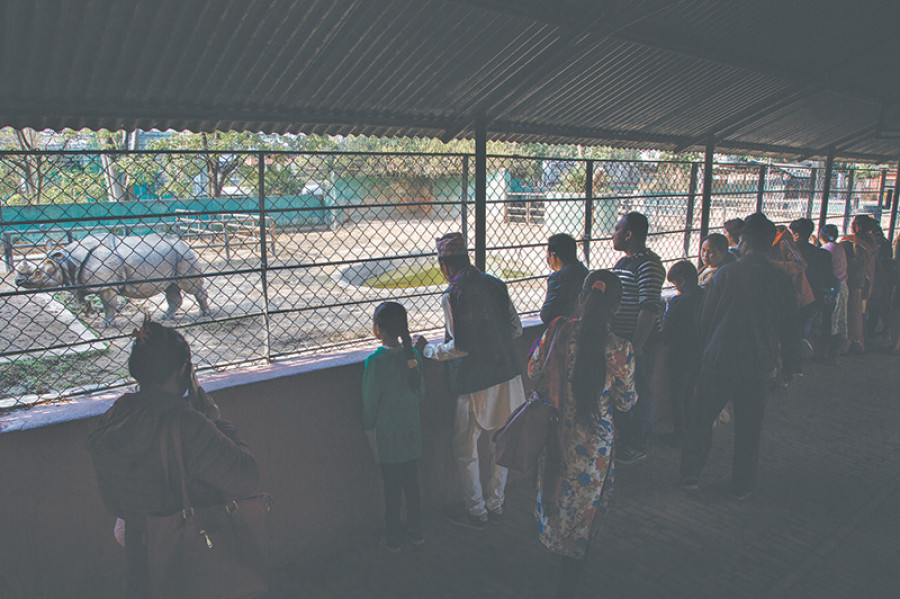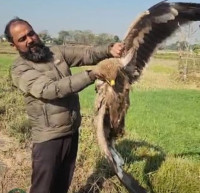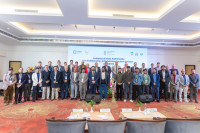National
Central Zoo looks to a sanctuary model
In December last year, two battered sloth bears from Rautahat were rescued by a team of animal protection activists and Nepal Police officials.
Marissa Taylor
In December last year, two battered sloth bears from Rautahat were rescued by a team of animal protection activists and Nepal Police officials. The two bears, 17-year-old Sridevi and 19-year-old Rangila, had been tortured and tormented into subjugation for years, forced to work as ‘dancing bears’ by their owners.
Once they were rescued, Nepali and Indian conservation officials decided that the pair would be sent to a bear sanctuary in Agra, India, where they could lead the remainder of their lives in freedom.
However, the bears were instead taken to the Central Zoo in Jawalakhel, where their conditions did not improve much. In March, Sridevi died inside the zoo’s premises. The zoo administration claimed that Sridevi was already unwell when she arrived at the zoo, and there was not much they could have done to save her. But animal welfare organisations blamed the zoo for its negligence and substandard care. They then pressed for the immediate transfer of Rangila to the sanctuary in India, where he now currently resides.
The primary objective of a zoo is to ensure and promote the conservation and protection of animals, especially those that are vulnerable to extinction, like sloth bears. But the Central Zoo’s infrastructure and the condition under which many of the animals live inside the premises show that it lacks the foresight and capability to take on such responsibilities.
The Central Zoo, the only formal zoo in the country, has often been subject to criticism for its lack of regulations and shoddy facilities. The Sridevi case was just one recent incident that reflected the zoo’s inadequacies and sparked mass anger and protest, especially from animal rights and welfare activists. It also provoked the age-old morality debate about the role of zoos—do we really need institutions whose foundations are built on the deprivation of animals’ liberty?
The design of a zoo is simple: animals are taken from their natural habitats, transported great distances, secluded, and kept in rigid, alien environments where their freedom is restricted—all in the name of conservation and recreation.
The Central Zoo, with an area of about six hectares, is home to 125 species—a total of more than 900 mammals, birds, fishes and reptiles. Every day, on an average, 2,000 to 3,000 people visit the Central Zoo. Tickets cost Rs 150 for adults (Rs 250 for SAARC country citizens and Rs 375 for foreigners), and the zoo earns an average of Rs 140 million annually in ticket sales alone. The thousands who flock to the zoo in Jawalakhel do so mostly for recreational purposes—to view the 900 caged animals, go boating, have a picnic and try a few rides at the recreational park. In Nepal, it seems that the Central Zoo is, for the most part, a place primarily for entertainment, not conservation.
Zoos as a concept, and a reality, came into operation relatively recently in the world, but people have been collecting exotic animals for thousands of years. In fact, the first zoos, or menageries, were created as private collections by the rich in the 18th century, with the first official zoo opening in Paris, France, in 1793. Zoos originated as little more than displays of power and wealth, which is exactly what Nepal did, back in 1932 when Rana Prime Minister Juddha Shumsher built his private zoo in Jawalakhel for his leisure.
It was only in 1950 that the Central Zoo came under the ownership of the government. And in 1995, the government entrusted the management of the zoo to the National Trust for Nature Conservation (NTNC), an autonomous body. Under NTNC’s governance over the years, the zoo has seen slow, gradual changes: the cages have become slightly more spacious, new animals have been added, the fun park inside the premises has additional recreational activities, there are drinking water fountains, and clean toilets are available for visitors.
Conservation and welfare
The Central Zoo’s main objectives, as listed on its official website, are to improve animals’ health and welfare by creating a natural habitat; to encourage research and captive breeding of rare animals; to provide conservation education through first-hand experience of wild animals; and to raise public awareness on the importance of nature conservation. But whether the zoo adheres to its own objectives is debatable.
“Our two focuses have always been the conservation of animals and spreading conservation awareness,” says Chiranjibi Pokharel, Central Zoo manager. “More than a third of the animals in the zoo was rescued. Animals that pose a threat to human lives, animals that are injured, and orphaned animals whose survival became difficult in their environments were rescued and brought to the zoo by official rescue teams.” Endangered animals like the rhinoceros, jungle cat and civet were rescued, according to Pokharel.
Nature conservation can be roughly divided into two types: in-situ conservation and ex-situ conservation. In-situ, or on-site, conservation is the conservation of natural resources and wildlife in their natural habitat; whereas ex-situ conservation is the preservation of components outside their natural habitats.
“In-situ conservation is the best form of conservation, of course. But, with habitats shrinking and climate change influencing weather patterns, the implementation of ex-situ conservation is unavoidable, and, in many ways, crucial to ensure the survival of the remaining of Nepal’s, and the world’s, endangered species,” says Nabin Gopal Baidya, programme manager at Wildlife Conservation Nepal (WCN).
“For example, if the habitat of Chitwan National Park is destroyed, then, with it, almost 50 percent of Nepal’s one-horned rhino population, which is listed as vulnerable, will be wiped out,” says Baidya. “But if we have a few rhinos safe in the zoo, we can keep the species alive. Look at a zoo as if it were a seed bank. If we look at it from that aspect, then, yes, zoos are important, at least for the conservation of wildlife. Having said that, how the animals in the zoo are kept is another matter altogether.”
Along with conserving animals, it is the duty of a zoo to provide animals the welfare they deserve and need. “When it comes to animal welfare, there are five freedoms that must be met: freedom from hunger, freedom from discomfort, freedom from pain, injury or diseases, freedom from fear and distress, and freedom to express normal behaviour. If a zoo does not meet any of these points, then the welfare of the animals has been compromised,” says Uttam Kafle, executive director at Animal Nepal.
However, this embrace of conservation by zoos doesn’t sit very well with animal activists, for zoos have genetically been a source of entertainment and business. This is evident in the revenue that the zoo generates along with the fact that two-thirds of the Central Zoo’s area is occupied by an amusement park and a pond. Most visitors, too, seem to come to the zoo not to learn but to enjoy themselves.
“I come to the zoo with my son regularly because he loves seeing the animals that are here. Besides that, the zoo also has a lot of options available for families to have a good time,” says Bhupal Koirala, who was visiting the Central Zoo for the fourth time this year. “However, the zoo is haphazardly managed. From the time I used to come here as a kid till today, the zoo hasn’t changed all that much.”
Pros and cons
Despite its conceptual flaws and infrastructural shortcomings, the Central Zoo does put in a lot of effort at wildlife conservation. The zoo’s officials assist research teams, and it also has a nursery, where the country’s rescued and injured animals are brought, because there is no other place the animals can be taken to.
The zoo has also recently started conducting breeding programmes, although not all of them have been successful. For instance, rhinos inside the zoo have not been able to breed even once since its establishment. This could be due to a lack of adequate space, say wildlife experts. Rhinos and other large animals need space—at least 10-30 metres—for courtship and mating rituals. The limited space available in the enclosures could be barring rhinos from breeding, but because the Central Zoo has not conducted any research on the topic as of yet, authorities say they cannot be certain.
The zoo administration’s efforts are sometimes met with disappointment because of the unavailability of space, a problem the administration can do little to solve. “We know that there is a space crunch. This zoo was originally built as a menagerie and not a national zoo, and we know how the lack of space affects the animals. But there is little we can do to address this problem,” says Pokharel.
The zoo also regularly hosts its innovative and educational ‘Friends of the Zoo’ campaign, which has more than 500 member schools. Another of the zoo’s primary focuses has always been on educating children about animal conservation, and organising interesting programmes for children—like animal feeding and night watch programmes—where children can learn more about animals via first-hand experience, develop a bond with them and in turn, care about their conservation.
However, experts opine that although it is undeniable that some education occurs in a zoo, there is very little evidence that can prove that zoos are successful in educating people about animals and conservation. “A zoo can be a place for students to learn, but I highly doubt students will get a comprehensive education by just seeing a caged wild animal,” says Kafle.
Mentally caged
According to the World Association of Zoos and Aquariums (WAZA), a global unifying organisation for the zoo and aquarium community, enclosures should provide “challenge and choice” for the animals and allow them some control over their own well-being “by choosing to move from place to place,” such as out of the sun, onto the grass, or toward their companions. The enclosures at the Central Zoo are so small that the animals barely have space to move around. Take, for example, Pawankali, the 71-year-old elephant, who has lived a large chunk of her life—more than three decades—in the Central Zoo, in chains and in solitude.
“Elephants are highly social animals that in the wild roam for hundreds of kilometres. In comparison to that, the elephant in the zoo has very little space to move around,” says Baidya. “In the Tarai, elephants from Parsa National Park walk hundreds of kilometres to come to Sauraha, Chitwan, during the breeding season,” he adds. By isolating elephants like Pawankali from other elephants, confining them to small concrete pens, and preventing them from moving more than a few feet is unnatural and cruel, and affects their mental health extensively.
Across the globe, animals held in captivity have been documented to display signs of depression and anxiety. This has become such a recurring phenomenon that psychologists have given this distress a name: zoochosis, where animals display unusual habits like rocking, swaying, excessively pacing, self-mutilation, biting and vomiting. In a video that went viral on YouTube, when Rangila was kept in the Central Zoo, he was seen displaying signs of distress—pacing back and forth and head-weaving. Whether he was distressed because of his state in the zoo, or because of all the trauma he had faced, we don’t know. Zoo authorities never released any statement regarding this issue.
Zoochosis is mostly seen in animals that are brought in from the wild to a zoo, but it can also be seen in animals that were bred in captivity, for even animals born in captivity feel their natural impulses to be free, to hunt for their own food—to be free to make their own choices.
“A zoo can teach you a lot about how animals behave in captivity but will teach you very little about the behaviour of animals in the wild,” says Kafle. The impact of routine confinement has grave impacts on the physical and psychological well-being of animals that are held in captivity, with some studies claiming that this even lessens the life expectancy of animals.
From zoo to sanctuary
The inadequacies of our zoo are a result of a combination of a lack of resources, the zoo’s central location, its low entry fees, lack of expertise and a lack of reinvestment in improvements. But because conservation of animals is a necessity of our times, and zoos do not provide animals with the welfare they need to thrive, a new approach towards wildlife conservation needs to be adopted, say activists.
The design of a zoo built for conservation cannot be similar to the design of a zoo built for recreation. One solution would be to have a sanctuary-style zoological garden, which is a step the Government of Nepal is reportedly already working towards. A new zoological garden is set to be built in Suryabinayak, Bhaktapur, and will cover an area of 245 hectares—immense compared to the current six hectares—and will be spread over seven community forests in Suryabinayak, Gundu, Sipadol and Katunje. The new zoological garden will also be equipped with modern facilities such as animal health care centres and recreational areas that are at a distance from the animals’ enclosures.
The Central Zoo administration says work on the project has already started. “We acknowledge that our zoo is very small in size, and we are very happy that a bigger, better facility is being constructed for the safeguarding of so many animals,” says Pokharel.
“The best way to ensure that these animals are conserved and their welfare not compromised is by building a sanctuary, or at least a zoo that follows the principles of a sanctuary,” agrees Kafle. The new zoo should be designed by keeping in mind the psychological and physical well-being of animals, and should imitate their natural habitats as much as possible. Besides taking care of the well-being and welfare of the animals, if the concept of ‘modern zoos’ can be implemented, then local tourism can also develop around the zoo, which will take care of the business side of things as well.
With rising awareness of animal rights and our move towards a more egalitarian society for all, not just humans, the place a zoo occupies within a humane and tolerant society needs to be interrogated. While protests have emerged against the animal sacrifice at the Gadhimai festival and against sacrifice during Dashain, the zoo has emerged relatively unscathed. As animal activists say, there needs to be an evolution in people’s understanding of what zoos are and what they can be.




 10.12°C Kathmandu
10.12°C Kathmandu















